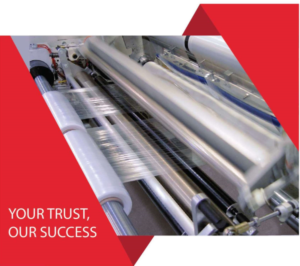How Are Plastic Bags Made? Step-By-Step Plastic Bag Production Process

Flexibility, lightness, and affordable prices are all advantages of plastic bags. For decades, plastic bags have been considered essential items in life and production. In today’s article, Hanpak JSC will introduce the most common method for producing conventional plastic bags, a process called blown film.
What are plastic bags made of?
Petrochemicals dominate the raw material stock for producing plastic bags. The vast majority of single use plastic bags are made out of a few structural chains of the molecule polyethylene.
With production continuing to increase dramatically, it is estimated that 100 million tons of polyethylene will be produced globally in 2018.
Approximately 6 percent of oil produced globally goes towards the plastic manufacturing industry, with plastic bags making up a considerable (35-40 percent) portion of plastics production.

The process of making plastic bags
#1 Extraction of raw material
The polyethylene that makes plastic bags is derived either from refined oil or cracked natural gas. These hydrocarbons are found mostly underground and must therefore be reached by drilling wells. This process disrupts the local ecosystem and can present disastrous consequences for human and environmental health if leaks occur.
The raw gas or oil is sent through pipes to a refinery, petroleum is separated at these sites into different densities so the right oil needed for plastics can be extracted.
This oil or gas is superheated and pressurized to isolate pure polyethylene chains which can be combined (polymerized) to form resin pellets of pure plastic.
Whether the product will be a grocery bag or a plastic shopping bag, different amounts of heat and pressure will be applied to create plastic resin pellets of different densities.
Grocery bags are often made from a high-density plastic (HDPE) which has a higher tensile strength compared to plastic films which are made from low-density plastic (LDPE or LLDPE).
#2 Extrusion of plastic film
To begin the manufacturing process, raw HDPE, LDPE, or LLPDE plastic pellets are again superheated and pressurized to form a uniform molten liquid-which air is pumped into from below, producing a long thin balloon of pliable plastic film that passes through a tall vertical corridor.
This plastic “bubble” cools as it expands upwards, encountering multiple rollers that stretch the plastic into thin sheets that will make the walls of the bag. These sheets are then rolled onto two separate flat beds and sent to the printing machine.
#3 Printing
Single use plastic bags are composed almost entirely of pure polyethylene molecules, however most plastic bags tend to have some form of branding printed onto them. The printing process for a sensitive and light material like a plastic bags requires a series of flexographic rollers that add color and type to the bags.
Printing requires additive dyes that can be toxic and could threaten marine organisms. However, safer alcohol-based inks can also be used and are starting to be introduced commercially.
Producing alcohols from sugary plant material helps lessen the negative environmental impact of dying plastic bags. Once the print has been applied to the bag it is sent to be converted into the finished product.
#4 Converting: Plastic bag making
The two printed sheets are then pressed at the edges to form the sides of the bag. The plastic can be wound and then cut to the desired shape and size, depending on the desired commercial intent for the bag.
At this point in the process custom options exist for altering the type of bag, for instance if the client wants to create a perforated bag for easy tearing (such as ones found in the produce section of grocery stores) they are able to do so.
The end

